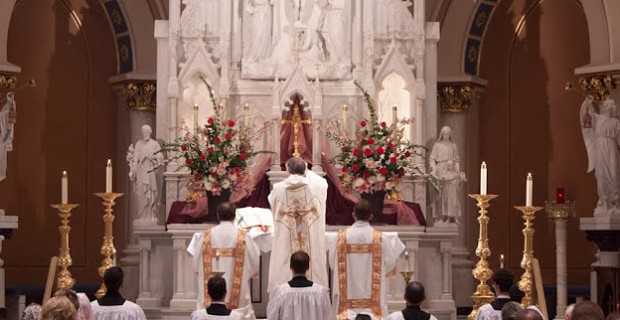

But are they not equal in their sacredness?
No, they are not equally sacred.
To defend the Pope:
What is the actual difference in the two masses, the TLM and the Novus Ordo? Isn’t Jesus as present in one as the other?
I understand that some prefer one over the other, and some priests are poor officiants. But are they not equal in their sacredness? And from the point of view of the presence of the Lord or the sacredness of the rite, the differences would be superficial.


But are they not equal in their sacredness?
No, they are not equally sacred.
ALPAPilot:
Ebb tide photo collage there is extremely descriptive.
Both the Tridentine (now officially called The Extraordinary Form) and Novus Ordo are valid masses, as you point out.
One of the key differences is the reverence shown to God during the whole of the Mass; and specifically to Christ in the Form of the Eucharist.
That second photo is a very common scene at large parishes just before Holy Communion, where a dozen or more Eucharistic Ministers, some better dressed than others (ahem...) are crowded around the Altar in a fashion that looks like chaos if you walked in right at that moment.
The loss of respect and decorum to Christ present makes more traditional Catholics, or even just more conservative and reserved individuals *cringe*.
To have the leader of your Church criticize you when you can plainly see and feel that something is wrong and inappropriate, is disheartening to say the least.
it has nothing to do with the personal sacredness of the priest. A priest can be the biggest whore master in the world —and in up a storm—that does not prevent the presence of Christ in the Eucharist. When they changed the rite from Tridentine to Novus Ordo they changed the emphasis from “a sacrifice” —or as my I guess there was a sort of thinking at the time —especially in North America, English speaking countries, and perhaps countries like Germany & Holland where u have a mixed Protestant/Catholic population—that if we make the mass less mysterious—less hocus pocus—they won’t think of us as so strange. The changes that did occur weren’t actually the original mind of the Vatican. The genie was out of the bottle. The mid to late sixties experienced crazy folk masses with nuns with guitars and a lot of bad music etc (although I have to say I did enjoy it as a kid of 10-11 years old). The priest became a personality and later on an amorphous kind of therapeutic feeling intruded itself on the mass. In the days of the old mass, I am sure there were good preachers ad awful preachers -maybe that was the only place where a priest’s personality came into play. This is the best way I can explain it.
The liturgical reform, in its concrete realization, has distanced itself even more from its origin. The result has not been a reanimation, but devastation. In place of the liturgy, fruit of a continual development, they have placed a fabricated liturgy. They have deserted a vital process of growth and becoming in order to substitute a fabrication.They did not want to continue the development, the organic maturing of something living through the centuries, and they replaced it, in the manner of technical production, by a fabrication, a banal product of the moment.
What happened after the Council was altogether different: instead of a liturgy fruit of continuous development, a fabricated liturgy was put in its place. A living growing process was abandoned and the fabrication started. There was no further wish to continue the organic evolution and maturation of the living being throughout the centuries and they were replaced -- as if in a technical production -- by a fabrication, a banal product of the moment. Gamber, with the vigilance of a true visionary and with the fearlessness of a true witness, opposed this falsification and tirelessly taught us the living fullness of a true liturgy, thanks to his incredibly rich knowledge of the sources. As a man who knew and who loved history, he showed us the multiple forms of the evolution and of the path of the liturgy; as a man who saw history from the inside, he saw in this development and in the fruit of this development the intangible reflection of the eternal liturgy, which is not the object of our action, but which may marvelously continue to blossom and to ripen, if we join its mystery intimately.
AMEN to that!
As long as they are both done in a reverent manner.
Been away for a couple of days and see that the debating over which mass is better still goes on.